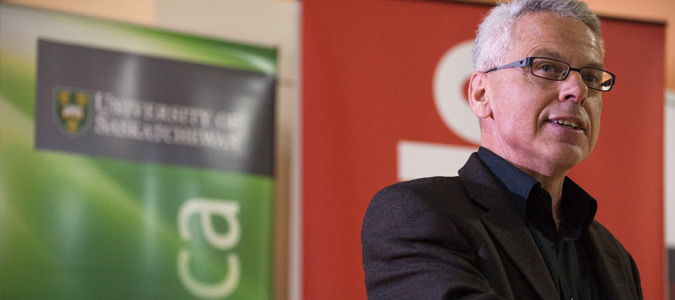On the road to reclamation
A few years ago, U of S Civil Engineer Lee Barbour took his wife Twila to the Mildred Lake oil sands mine site operated by Syncrude, just north of Fort McMurray. Barbour had been working with Syncrude on reclamation research projects since 1998 and wanted to show his wife his work.
By Kris Foster "Driving towards Fort McMurray, along the Athabasca River in the middle of boreal forest, is just beautiful," said Barbour. "After a short drive along the beautiful Athabasca River valley we came up over a small rise and suddenly in front of us was this panoramic view of the highway, passing like a long causeway between two gaping open pits steaming with newly placed tailings—the dark shadow and flares of the refinery at the end of the causeway. For a moment we felt like a couple of hobbits on a quest towards Mordor," a reference to Tolkien's The Lord of the Rings.
"Driving towards Fort McMurray, along the Athabasca River in the middle of boreal forest, is just beautiful," said Barbour. "After a short drive along the beautiful Athabasca River valley we came up over a small rise and suddenly in front of us was this panoramic view of the highway, passing like a long causeway between two gaping open pits steaming with newly placed tailings—the dark shadow and flares of the refinery at the end of the causeway. For a moment we felt like a couple of hobbits on a quest towards Mordor," a reference to Tolkien's The Lord of the Rings.Barbour recalled looking at his wife and seeing a tear in her eye as she asked, "What are they doing?" However, when he took Twila to a reclaimed overburden at the same mine site later that day, "I noticed how her face lightened as we came across a beautiful wetland, surrounded by trees and grasses, birds flying overhead." The site was called Bill's Lake, named after a colleague who started reclamation research at Syncrude with Barbour many years ago. Barbour added that Bill's Lake is much closer to the Shire than Mordor.
Barbour's Tolkein analogy is quite apt for his research. "The discussion around oil sands mining is becoming increasingly polarized in our society. Some see only Mordor while others wistfully dream of the Shire. There are lots of good reasons to believe that there is a path between Mordor and the Shire but it is a path that will be mapped out through sound research partnerships."
Barbour will now have more support than ever in his quest to find that path—he was recently awarded a five-year Industrial Research Chair (IRC) in Hydrogeological Characterization of Oil Sands Mine Closure Landforms, funded with $2.6 million contributed equally by the Natural Sciences and Engineering Research Council (NSERC) and Syncrude. Syncrude and the U of S will provide an additional $1 million of in-kind support.
"The key questions revolve around what it will take to restore these mine sites back to naturally performing landscapes with an equivalent capability to that which existed prior to mining. The industry works to establish uplands with water and nutrient balances, which are similar to natural sites. They then try to understand the key processes that are operative as they monitor the evolution of these landforms towards fully functioning natural systems."
It is easy to blame corporations, explained Barbour, but they are working within the rules and regulations government and society have put in place.
"We all want to crucify big business, but these companies have agreements with the government. Part of that agreement is to restore the environment to an equivalent capability to that present before their temporary use of the land for mining. The research helps to guide the industry efforts in reaching their reclamation goals."
Barbour's new research will examine the movement of water and chemical species of interest within the large upland structures built during mining. "We want to help develop strategies to ensure that water released after mine closures doesn't have a detrimental impact on the environment. The methods developed in this research will be applicable not only at oil sands mines but at other mine sites as well."
He noted that it is a daunting project, and yet just a small component of the much larger research program funded by Syncrude that includes support for 10 other NSERC-IRCs.
In carrying out his work, Barbour will call on the expertise of many colleagues in many different units—including geology and soil science—across campus. "I often remind young engineers that their career success will depend on their ability to cultivate strong relationships. This type of research would not be possible without strong, relationship-based, multidisciplinary, collaborative research."
The chair appointment will allow Barbour to train two postdocs, two PhDs, six masters' students and two undergraduate students. He and his team will also have the opportunity to work with Syncrude's scientists and engineers. "It is in large measure the energy and passion that these researchers bring to this journey that gives me the encouragement I need to take this on."

